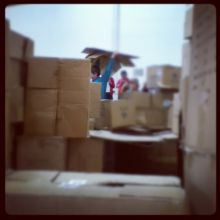Digital Reporters at Camp Cardboard
- 21st century show and tell
- Creating Digital Paintings using iPads
- Creating Instructional Videos
- Creating and Using OERs to Promote Best Practice
- Digital Reporters at Camp Cardboard
- Digital video in ITE
- Exploring the intersections of digital literacy and creativity
- The use of mobile apps for digital story-telling with nursery pupils
- Using QR Codes to Engage Children with Learning
Lesson idea. This lesson idea involves the use of iPads and iPod Touches with a KS2 class, with the children taking on the role of 'digital reporters'. This series of lessons was linked to a whole school event called 'Camp Cardboard', run by artists from a group called Responsible Fishing (http://www.responsiblefishinguk.co.uk/) over the course of a full day. They provided a large amount of recycled cardboard boxes to the school hall and worked throughout the day with each year-group to build a cardboard camp, using the children's ideas to construct rooms, tunnels and even a cardboard garden.
The digital element of this project involved teams of children from the class visiting the hall, acting as reporters to record the events unfolding. They used the Instagram app to take and manipulate photos and to add filters. They also used the notes app to make notes on what they saw.
On return to the classroom the children used the same mobile devices to add posts to a blog about their day. This initially involved discussions about eSafety and the audience of the blog. The children produced a range of interesting and individual blog posts that incorporated their photos and text, using the Wordpress app to post their ideas.
Parents and members of the project team were asked to contribute comments to the blog and to interact with the children while they were blogging. The blog can be found at http://cardboardbds.wordpress.com
Children took a creative and positive approach to using the technology, working successfully with the apps they had been introduced to, finding their own way around problems that arose and using their initiative to explore alternative uses that supported their aims.
Teaching approach. This activity is a cross curricula(subject) activity, involving a collaborative(tool) approach, giving children the opportunity to work together on a blog. Children were encouraged to engage in group talk(ta) and discussion(ta) in the classroom to reflect on the activity they were to report on. The activity furthers e-skills(topic) and e-safety(topic) through the use of whole class(ta) participation. The specific art activity provided a great stimulus for the blogging. Equally, however, this approach could be applied to any event in or out of school. The use of blogging and social media gave the opportunity for children to share their ideas with a wider audience, and also gave opportunities for real-time feedback to their work. The use of hand-held technology also enabled active learning(ta) as the portability of the iPads and iPods allowed them to be used outside the classroom. (edit)
| Resource details | |
| Title | Digital Reporters at Camp Cardboard |
| Topic | [[Topics/E-safety|E-safety]], [[Topics/Blogs|Blogs]], [[Topics/E-skills|E-skills]] |
| Teaching approach | [[Teaching Approaches/Group talk|Group talk]], [[Teaching Approaches/Whole class|Whole class]], [[Teaching Approaches/Active learning|Active learning]], [[Teaching Approaches/Discussion|Discussion]] |
| Learning Objectives | To use technology to communicate an event to a wider audience |
| Subject | [[Resources/Literacy|Literacy]], [[Resources/Cross curricula|Cross curricula]], [[Resources/Science|Science]], [[Resources/ICT|ICT]], [[Resources/Cross-curricular|Cross-curricular]], [[Resources/Art|Art]] |
| Age of students / grade | [[Resources/8-10|8-10]], [[Resources/Primary|Primary]], [[Resources/KS2|KS2]] |
| Additional Resources/material needed | iPads / iPod Touch |
| Useful information | The Instagram and Wordpress apps can be downloaded free from the Apple App store |
| Related ORBIT Wiki Resources | |
| Files and resources to view and download | This lesson idea comes from the DEFT case study A schools involvement with Sheffield Childrens Festival project Camp Cardboard. The whole case study is available for reading and downloading here: http://www.digitalfutures.org/index.php/case-studies/schools/school-case-study-5/
|


